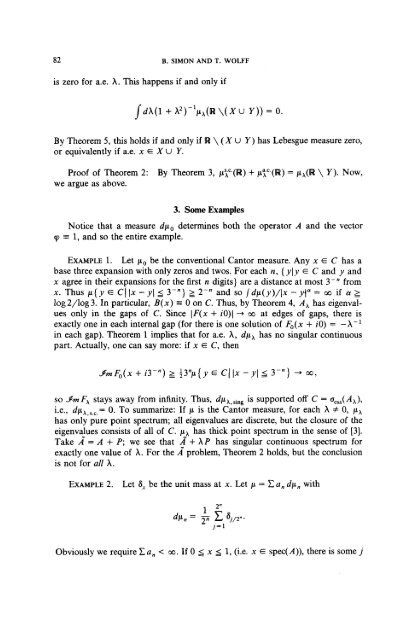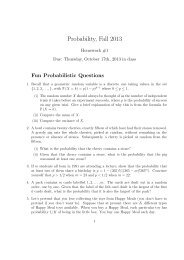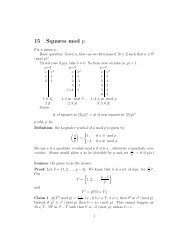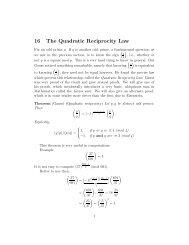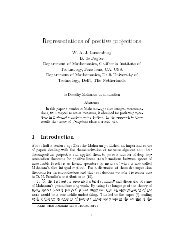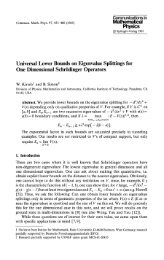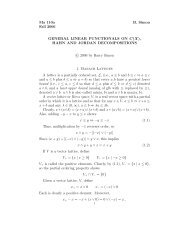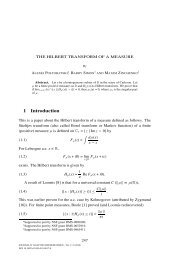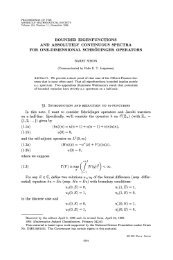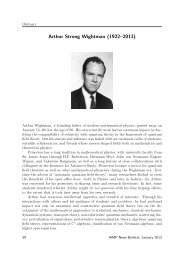Singular continuous spectrum under rank one perturbations and ...
Singular continuous spectrum under rank one perturbations and ...
Singular continuous spectrum under rank one perturbations and ...
Create successful ePaper yourself
Turn your PDF publications into a flip-book with our unique Google optimized e-Paper software.
82 B. SIMON AND T. WOLFF<br />
is zero for a.e. A. This happens if <strong>and</strong> only if<br />
ldA(1 + A2)-1pA(R \(XU Y)) = 0.<br />
By Theorem 5, this holds if <strong>and</strong> only if R \ (X U Y ) has Lebesgue measure zero,<br />
or equivalently if a.e. x E X U Y.<br />
Proof of Theorem 2: By Theorem 3, py(R) + p;'.(R) = px(R \ Y). Now,<br />
we argue as above.<br />
3. Some Examples<br />
Notice that a measure dp,, determines both the operator A <strong>and</strong> the vector<br />
q = 1, <strong>and</strong> so the entire example.<br />
EXAMPLE 1. Let po be the conventional Cantor measure. Any x E C has a<br />
base three expansion with only zeros <strong>and</strong> twos. For each n, { yly E C <strong>and</strong> y <strong>and</strong><br />
x agree in their expansions for the first n digits} are a distance at most 3-" from<br />
x. Thus p{y E C( )x - yJ 5 3-"} 2 2-" <strong>and</strong> so /dp(y)/lx - yla = co if a 2<br />
log2/log3. In particular, B(x) = 0 on C. Thus, by Theorem 4, A, has eigenvalues<br />
only in the gaps of C. Since IF(x + iO)( --j 00 at edges of gaps, there is<br />
exactly <strong>one</strong> in each internal gap (for there is <strong>one</strong> solution of Fo(x + i0) = -A-'<br />
in each gap). Theorem 1 implies that for a.e. A, dpA has no singular <strong>continuous</strong><br />
part. Actually, <strong>one</strong> can say more: if x E C, then<br />
,amF,(x + i3-") 2 $3"p{ y E C( Ix - y( 5 3-"} + 0O,<br />
so J~z FA stays away from infinity. Thus, dpA,,ing is supported off C = ueess(AA),<br />
i.e., dpx,,.,,= 0. To summarize: If p is the Cantor measure, for each A # 0, pA<br />
has only pure point <strong>spectrum</strong>; all eigenvalues are discrete, but the closure of the<br />
eigenvalues consists of all of C. pA has thick point <strong>spectrum</strong> in the sense of [3].<br />
Take 2 = A + P; we see that A + AP has singular <strong>continuous</strong> <strong>spectrum</strong> for<br />
exactly <strong>one</strong> value of A. For the A problem, Theorem 2 holds, but the conclusion<br />
is not for all A.<br />
EXAMPLE 2. Let 6, be the unit mass at x. Let p = Can dp, with<br />
Obviously we require E a,, < 00. If 0 x 5 1, (i.e. x E spec(A)), there is some j<br />
2"


